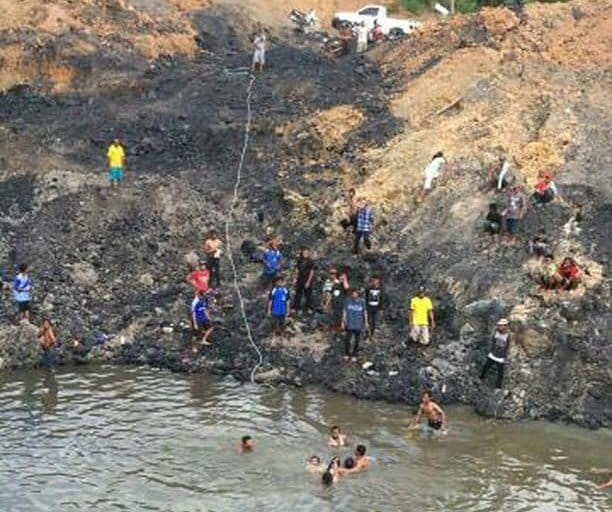- Two inactive coal open-pits, each of which has claimed the life of a child in Indonesia’s East Kalimantan, have been set for a restoration initiative led by the government.
- The government insists that owners of the abandoned mine pits will be held fully responsible for the costs of restoration work.
- The move comes amid a national plan to relocate the country’s capital from Jakarta to the Bornean province, so the abandoned pits have been identified as a top problem that needs solving.
- Environmentalists welcome the initiative to restore the abandoned open-pits, but said that turning them into agritourism sites was not a solution, as it would likely create new problems.
SAMARINDA, Indonesia — Two abandoned open-pit coal mines, each of which has claimed the life of a child in Indonesia’s Eastern Kalimantan province, have been earmarked for restoration efforts led by the government amid a major plan to relocate the country’s capital to the region.
For decades, this province in Indonesian Borneo has seen much of its land torn open by companies mining its coal. Around 40% of the province’s land is earmarked for coal concessions, including more than 70% of the Samarinda municipality.
Coal companies are required by law to clean up the damage they leave behind, filling in mining pits that are no longer in use and re-vegetating or restoring mining sites.
However, the companies often flout this particular responsibility. According to the Mining Advocacy Network (Jatam), East Kalimantan has 1,735 inactive open pit mines that belong to 1,404 companies.

With laws requiring post-mining reclamation poorly enforced, abandoned pits are left to fill with acidic water, creating deep, deadly pools. In the last eight years, more than 35 people, mostly children, have drowned in these holes.
Government officials, meanwhile, tend to blame the families for their children’s deaths, attributing them to parental negligence. But following the August 2019 announcement that East Kalimantan has been selected as the site of the country’s new administrative capital, the province’s abandoned mine pits have come into the national spotlight as a problem that needs to be solved.
“East Kalimantan has [a] mining pits emergency and they must be reclaimed,” said Pradarma Rupang, who heads Jatam’s East Kalimantan chapter.
A joint team from the country’s environment ministry and East Kalimantan administration in October paid a visit to two of these pits. One belonged to PT Lanna Harita Indonesia (LHI), while the other is owned by PT Insani Bara Pratama (IBP). Each company is responsible for a mine pit in which a child died.
“Together with the central government, we’re committed to resolving the issue of ex-mine pits,” said East Kalimantan government spokesperson HM Syafranuddin. “All abandoned mine pits will be dealt with, and once it’s resolved, we hope there won’t be any more deaths.”
The environment ministry said that owners of the abandoned mine pits would be held fully responsible for the costs of restoration works.
Syafranuddin said the pits will be reclaimed and repurposed as facilities that benefit the people living in the vicinity, such as agritourism sites where communities can grow local fruits.
“Restoration efforts need support from all stakeholders, not only the central and provincial government, but also the people of East Kalimantan,” Syafranuddin said, adding that the government hoped the work on PT LHI and PT IBP’s mine pits could be an example that others would replicate.

PT LHI has two open-pits spanning a total 1.45 hectares, with another 10.29 hectares within the concession degraded by mining. Meanwhile, PT IBP’s pit stretches 0.22 hectare, but its mining activities have degraded an area of 14.26 hectares. For PT IBP’s concession, the government has requested the company to fill the pit so the site can be recovered to a protected area, according to Samarinda’s city planning.
“The environment ministry wants to show that if the planning is well done, then the result will be good as well,” said M.R. Karliansyah, the director general for environmental degradation, mitigation, and control at the ministry.
Environmentalists welcome the initiative to restore the abandoned open-pits, but said that turning them into agritourism sites was not a solution as it would likely create new problems.
“After the pits are remodified, who will monitor them? Who will take care of the costs for maintenance and management? It will be the people,” said Jatam’s Pradarma.
Observers are also calling on the government to review the environmental impact assessment papers of the companies — PT LHI and PT IBP — before carrying out restoration work on the open pits.
“Do the documents say that the pits will be closed up, reclaimed or turned into [an] agritourism site? If what they’re doing is different than what’s stated in the documents, then both companies are not acting in accordance with the law,” said Siti Kotijah, a legal lecturer on mining at Mulawarman University.
“They must proceed according to the regulations, including getting approval from the people living in the vicinity of the ex-mining pits,” she added.

This story was first reported by Mongabay’s Indonesia team and published here on our Indonesian site on Oct. 26, 2019.
FEEDBACK: Use this form to send a message to the author of this post. If you want to post a public comment, you can do that at the bottom of the page.